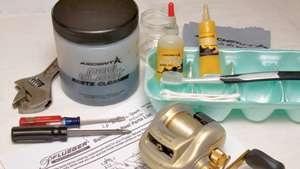
If your reels squawk and refuse to cast as far as they once did, they’re long overdue for a thorough cleaning. This should be done annually to every reel in any serious bass angler’s arsenal. It keeps them running smoothly and adds years of life.
Before tearing into a reel, assemble everything you’ll need. That includes the reel’s schematic, the appropriate screwdrivers and wrenches, cleaning solution, a toothbrush, a lint-free cloth or paper towels, cotton swabs, lubricants and an empty egg carton or two. If you don’t have the schematic, contact the manufacturer for one. Or, go to MikesReelRepair.com.
Here you’ll find free schematics for most reels that you can download and print. Lay everything out on a clean, light-colored towel or T-shirt that you can soil without getting into trouble. It makes tiny parts easy to see and prevents them from bouncing into an invisible fourth dimension when you inevitably drop them.
Cleaning solvents
The cleaning solvent must be mild so it doesn’t damage plastic parts. It should also dry without leaving a residue. Ardent’s citrus-based reel solvent, used in this photo essay, meets these criteria. Isopropyl rubbing alcohol will do if a reel needs only minor cleaning, said Dan Thornburn, a Shimano reel guru who does reel maintenance clinics at sports shows.
He applies the alcohol with a pump spray bottle. “For heavy cleaning, I use Crystal Simple Green cleaner,” Thornburn said. After spraying reel parts, Thornburn scrubs them with a toothbrush. When using Crystal Simple Green, he rinses the parts with water.
You can clean a reel with a degreaser like WD-40, but it leaves a film when it dries that needs to be washed off with soapy water. This adds an extra step.
Reel lubricants
Abu Garcia, Ardent, Quantum and Shimano are among the companies that make grease and oil specifically for fishing reels. You can’t go wrong using the lubricants sold by the company that made your reel. Because WD-40 is a degreaser, it breaks down grease and oil.
Never use it to lubricate a reel. The basic rule of thumb is to grease gears and oil everything else — sparingly. Too much grease and oil impede the spool and reduce casting distance. Reapply oil once or twice a month between the annual cleaning. With many reels, only the main drive gear should be greased.
Dale Nissen, senior repair technical for Pure Fishing, oils the levelwind’s exposed worm gear for freshwater applications. “Grease holds dirt and can wear out a worm gear in one season,” Nissen stressed.
Cleaning
Before you tear down a reel, place everything you need on a lightly colored towel or T-shirt so you can easily see tiny parts.
To simplify the reassembly, place the reel’s parts into an egg carton in the order they are removed. Spray or soak gears and other parts in a cleaning solution. However, soak bearings in a separate solution to keep them free from grime. Scrub gears and other parts with a toothbrush. It is crucial to clean the inside of the pinion gear so the spool shaft spins freely.
Ardent makes small foam swabs that work for this. Clean the case for the casting brakes to ensure silky smooth backlash control. Wipe drag washers clean with a dry cloth. Apply whatever lubricant is recommended (if any) by the manufacturer. If you soak bearings, do so in a separate solution to avoid contaminating them with grit from other parts.
Dry the cleaned parts with a lint-free cloth or paper towels. Use cotton swabs for tight spots.
Lubrication
Apply one drop of oil to all bearings and lightly oil the case for the casting brakes. Apply a dab of oil to each brake collar. One drop of oil will do on the spool’s shaft. Work grease into the main drive gear with your fingers.
Don’t overdo it or grease will get on the spool shaft and hinder casting distance. Place one drop of oil on each end of the levelwind shaft and one drop directly on the worm gear.
Spinning Reel Particulars
Lightly oil the line roller assembly on the bail. Oil the bail arm assembly. Oil the drive gear bearings under the handle. Place three drops of oil into the maintenance port, if the reel has one.
Originally published March 2011





